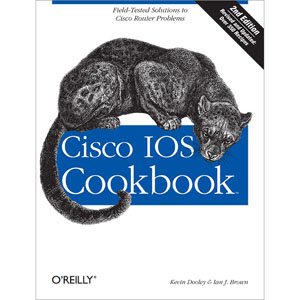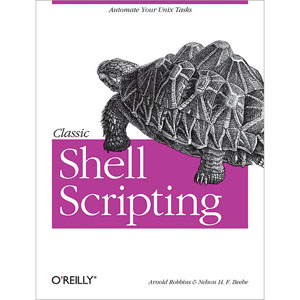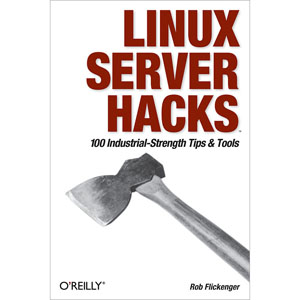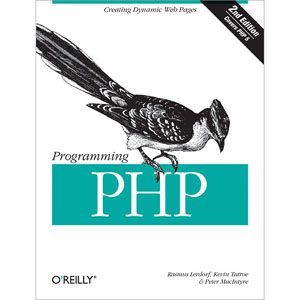5 new posts |  |
- Active Directory Cookbook, 3rd Edition
- Cisco IOS Cookbook, 2nd Edition
- Classic Shell Scripting
- Linux Server Hacks: 100 Industrial-Strength Tips and Tools
- Programming PHP, 2nd Edition
| Active Directory Cookbook, 3rd Edition Posted: 01 Sep 2011 04:46 AM PDT
Book DescriptionWhen you need practical hands-on support for Active Directory, the updated edition of this extremely popular Cookbook provides quick solutions to more than 300 common (and uncommon) problems you might encounter when deploying, administering, and automating Microsoft’s network directory service. For the third edition, Active Directory expert Laura E. Hunter offers troubleshooting recipes based on valuable input from Windows administrators, in addition to her own experience. You’ll find solutions for the Lightweight Directory Access Protocol (LDAP), ADAM (Active Directory Application Mode), multi-master replication, Domain Name System (DNS), Group Policy, the Active Directory Schema, and many other features. The Active Directory Cookbook will help you:
Each recipe includes a discussion explaining how and why the solution works, so you can adapt the problem-solving techniques to similar situations. Active Directory Cookbook is ideal for any IT professional using Windows Server 2008, Exchange 2007, and Identity Lifecycle Manager 2007, including Active Directory administrators looking to automate task-based solutions. “It is rare for me to visit a customer site and not see a copy of Active Directory Cookbook on a shelf somewhere, which is a testament to its usefulness. The Cookbook takes the pain out of everyday AD tasks by providing concise, clear and relevant recipes. The fact that the recipes are provided using different methods (graphical user interface, command line and scripting) means that the book is suitable for anyone working with AD on a day-to-day basis. The introduction of PowerShell examples in this latest edition will be of particular interest for those looking to transition from VBScript. Laura has also done a great job in extending the Cookbook in this edition to encompass the broad range of changes to AD in Windows Server 2008.” “If you already understand Active Directory fundamentals and are looking for a quick solution to common Active Directory related tasks, look no further, you have found the book that you need.” “The Active Directory Cookbook is the real deal… a soup-to-nuts catalog of every administrative task an Active Directory administrator needs to perform. If you administer an Active Directory installation, this is the very first book you have to put on your shelf.” Book Details
Related Posts
|
| Cisco IOS Cookbook, 2nd Edition Posted: 01 Sep 2011 04:43 AM PDT
Book DescriptionNever has something cried out for a cookbook quite as much as Cisco’s Internetwork Operating System (IOS). IOS is powerful and flexible, but also confusing and daunting. Most tasks can be accomplished in several different ways. And you don’t want to spend precious time figuring out which way is best when you’re trying to solve a problem quickly. That’s what this cookbook is for. Fortunately, most router configuration tasks can be broken down into several more or less independent steps: you configure an interface, you configure a routing protocol, you set up backup links, you implement packet filters and other access control mechanisms. What you really need is a set of recipes that show you how to perform the most common tasks, so you can quickly come up with a good configuration for your site. And you need to know that these solutions work: you don’t want to find yourself implementing a backup link at 2 A.M. because your main link is down and the backup link you set up when you installed the router wasn’t quite right. Thoroughly revised and expanded, Cisco IOS Cookbook, 2nd Edition, adds sections on MPLS, Security, IPv6, and IP Mobility, and presents solutions to the most common configuration problems, including:
If you work with Cisco routers, you need a book like this to help you solve problems quickly and effectively. Even if you’re experienced, the solutions and extensive explanations will give you new ideas and insights into router configuration. And if you’re not experienced–if you’ve just been given responsibility for managing a network with Cisco routers–this book could be a job-saver. About the Author Ian J. Brown is a Cisco Certified Internetworking Expert with more than 12 years of experience in the networking industry. His areas of expertise include TCP/IP and IP routing, as well as management, security, design, and troubleshooting for large-scale networks. Book Details
Related Posts
|
| Posted: 01 Sep 2011 04:41 AM PDT
Book DescriptionShell scripting skills never go out of style. It’s the shell that unlocks the real potential of Unix. Shell scripting is essential for Unix users and system administrators-a way to quickly harness and customize the full power of any Unix system. With shell scripts, you can combine the fundamental Unix text and file processing commands to crunch data and automate repetitive tasks. But beneath this simple promise lies a treacherous ocean of variations in Unix commands and standards. Classic Shell Scripting is written to help you reliably navigate these tricky waters. Writing shell scripts requires more than just a knowledge of the shell language, it also requires familiarity with the individual Unix programs: why each one is there, how to use them by themselves, and in combination with the other programs. The authors are intimately familiar with the tips and tricks that can be used to create excellent scripts, as well as the traps that can make your best effort a bad shell script. With Classic Shell Scripting you’ll avoid hours of wasted effort. You’ll learn not only write useful shell scripts, but how to do it properly and portably. The ability to program and customize the shell quickly, reliably, and portably to get the best out of any individual system is an important skill for anyone operating and maintaining Unix or Linux systems. Classic Shell Scripting gives you everything you need to master these essential skills. About the Author Nelson Beebe is a long time Unix user and system administrator, and has helped for years on Usenet newsgroups. Book Details
Related Posts
|
| Linux Server Hacks: 100 Industrial-Strength Tips and Tools Posted: 01 Sep 2011 04:37 AM PDT
Book DescriptionA competent system administrator knows that a Linux server is a high performance system for routing large amounts of information through a network connection. Setting up and maintaining a Linux server requires understanding not only the hardware, but the ins and outs of the Linux operating system along with its supporting cast of utilities as well as layers of applications software. There’s basic documentation online but there’s a lot beyond the basics you have to know, and this only comes from people with hands-on, real-world experience. This kind of “know how” is what we sought to capture in Linux Server Hacks. Linux Server Hacks is a collection of 100 industrial-strength hacks, providing tips and tools that solve practical problems for Linux system administrators. Every hack can be read in just a few minutes but will save hours of searching for the right answer. Some of the hacks are subtle, many of them are non-obvious, and all of them demonstrate the power and flexibility of a Linux system. You’ll find hacks devoted to tuning the Linux kernel to make your system run more efficiently, as well as using CVS or RCS to track the revision to system files. You’ll learn alternative ways to do backups, how to use system monitoring tools to track system performance and a variety of secure networking solutions. Linux Server Hacks also helps you manage large-scale Web installations running Apache, MySQL, and other open source tools that are typically part of a Linux system. O’Reilly’s new Hacks Series proudly reclaims the term “hacking” for the good guys. Hackers use their ingenuity to solve interesting problems. Rob Flickenger is an experienced system administrator, having managed the systems for O’Reilly Network for several years. (He’s also into community wireless networking and he’s written a book on that subject for O’Reilly.) Rob has also collected the best ideas and tools from a number of other highly skilled contributors. Written for users who already understand the basics, Linux Server Hacks is built upon the expertise of people who really know what they’re doing. “The book is such fun, that it has become a great way to test the memory and knowledge of other admins with quickfire questions over a drink. Overall the book is an excellent source of quick fixes for common problems.” Linux Magazine, August 2003 “Definitely one for the bookshelf.” Computer Shopper, March 2004 Book Details
Related Posts
|
| Posted: 01 Sep 2011 04:00 AM PDT
Book DescriptionProgramming PHP, 2nd Edition, is the authoritative guide to PHP 5 and is filled with the unique knowledge of the creator of PHP (Rasmus Lerdorf) and other PHP experts. When it comes to creating websites, the PHP scripting language is truly a red-hot property. In fact, PHP is currently used on more than 19 million websites, surpassing Microsoft’s ASP .NET technology in popularity. Programmers love its flexibility and speed; designers love its accessibility and convenience. As the industry standard book on PHP, all of the essentials are covered in a clear and concise manner. Language syntax and programming techniques are coupled with numerous examples that illustrate both correct usage and common idioms. With style tips and practical programming advice, this book will help you become not just a PHP programmer, but a good PHP programmer. Programming PHP, Second Edition covers everything you need to know to create effective web applications with PHP. Contents include:
Praise for the first edition: “I think this is a great book for programmers who want to start developing dynamic websites with PHP. It gives a detailed overview of PHP, lots of valuable tips, and a good sense of PHP’s strengths.” Book Details
Related Posts
|
| You are subscribed to email updates from Wow! eBook - Blog To stop receiving these emails, you may unsubscribe now. | Email delivery powered by Google |
| Google Inc., 20 West Kinzie, Chicago IL USA 60610 | |






Tidak ada komentar:
Posting Komentar